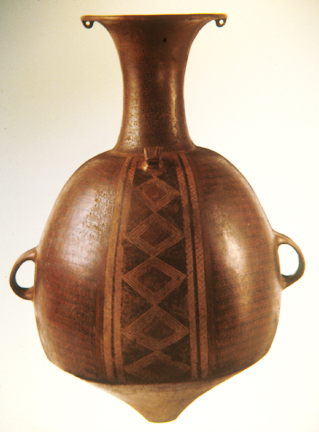Following the Nazca to power in south coastal Peru were the Inca, the people encountered by Francisco Pizarro in 1532. The Inca society was highly stratified and ruled by an emperor and an aristocratic bureaucracy. Their architecture and technology were sophisticated but not considered innovative. The Inca were great assimilators instead, similar to the Romans. Remains of Inca irrigation systems, palaces, temples, and roads can be seen throughout the Andes. Inca roads consisted of two main routes: one along the coast and another inland along the ridge of the Andes, with many interconnecting links. The roads were for the exclusive use of the government and the military. While the Inca had no written language they did use a system of knotted ropes to convey message. As described by the Spanish, who marveled at the ability of their Inca adversaries to share tactical information, runners would carry these ropes with patterns of complex knots, to deliver messages to distant rulers along the system of roads at the rate of 150 miles per day. These same roads would become part of the downfall of the Inca empire, as the Spanish made great use of them to transport troops and supplies (as well as disease). Pizarro and his men arrived in 1532 and by 1535, the Inca empire was no more, having surrendered in all but a few isolated mountain redoubts, such as Machu Pichu. For the student of the history of ceramics, it is fortunate that Pizarro was much more interested in Inca gold than Inca ceramics. Much of the gold was shipped back to Spain, into Seville to be melted down into ingots, to fill the coffers of the church and the king. The Inca ruler at that time was Atahualpa, and if one goes today to the Palacio Nacional in Madrid, one can see small statues dedicated to both him and Moctezuma (of the defeated Aztecs) just outside the entrance to this huge palace of over 2000 rooms, full of the gold from the captured colonies. Given that Atahualpa and Moctezuma had paid for all of this finery, one would think they might have been given a bit more recognition.
This is one of the finest examples of Inca ceramics and is called a Cuzco bottle. Cuzco was the administrative capital of the Inca empire, which at its height ruled over 12 million people. This beautiful and functional form was used to carry, store, and dispense water. Its pointed base had a function. It was placed on the ground or on a table tilted on the base, and when someone wanted a drink, the vessel was simply tipped forward. The two handles located near the center of the piece were used in concert with the small appendage at the neck so that a strap could be slid through one handle, then up and over the small protrusion, then down the through the opposite handle, and then the strap tied about the waist and shoulders and the pot could be easily carried with spilling any water. The two small lugs at the rim were for tying a skin or cloth over the top to keep out insects and debris making this a highly functional form. The similarities to the Greek amphora have been noted many times. Inca vessels were coiled and not molded and this specific form is called an aryballos. The slip design is finely painted and may represent basketry patterns.

Cuzco Bottle, Inca, South Coastal Peru
Post Classic Period, 1000-1500 CE


